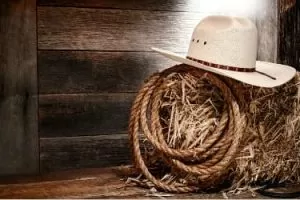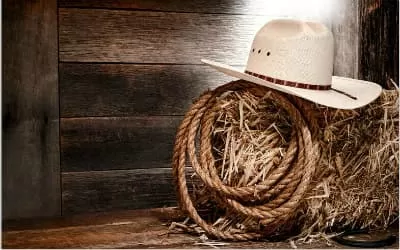Any of the jeans accessories can become a beautiful complement when dressing with this style so used by many men, women, children and also in horses
They are high boots with high heels to prevent them from sliding through the stirrups of the saddle and as a corset on the rope. The soles are usually made of smooth leather to prevent them from falling off when dismounting. Styles are often regional and defined by function.
This style of boots you get in our online shop, combined with a cowboy style hat, big or small spurs, cowboy buckles, bolo ties or jeans, also wallets make up the real cowboy style. Much of the style and many of the terms used in reference to cowboy accessories come from the regions where horses occupy a prime position in the productive and folkloric levels of the area. These accessories often fit their shape and style depending on the location where they are produced. Many of the definitions and terms for cowboy come from and are derived from the Spanish language.
We give you a sample of the terms used in Latin American lands such as Mexico, Peru and in Hispanic influenced areas of the United States such as Texas. You can search for a particular term or browse through the terms and explanations of a cowboy’s personal clothing and accessory equipment.
Cowgirl & Cowboy Hats. In American Men’s and Women’s Versions
A cowboy hat, usually with a four to six inch brim, acts as an umbrella in stormy weather, and a shade from the sun when it is hot. Hats and their shapes are very regional. You can see where a cowboy is working by the fold in his hat. John B. Stetson is credited with designing and marketing the first real cowboy hat, which he called the “Chief of the Plains”. It is a Spanish term that comes from the Spanish word “sombra”.
Bags as an Accessory
CHAPS: Derived from the Spanish Chaparreras, or Chaparejos
Also called chaps as sturdy leg coverings consisting of gaiters and a belt. They fit over the trousers with an integrated belt, but unlike the trousers they do not have a seat and are not joined at the crotch. It is a type of leotard used by horses as protection against the bush and the weather. They are usually made of leather.
Sock is Another Complement to Cowboy Style
A version of California socks, in Spanish, similar to the cracks, but handmade, usually without metal structure.
Roper Boots is Another Cowboy Accessory
Roper boots with flat heels are used especially in sand and for walking. Other boots with laces are made of leather for cold weather, hiking and hard riding.
Cowboy Shields
Different designs, sometimes with large leather fins. Usually used on rings and pins.
Chaparreras or Riding Aprons, Originally from California
Usually with bangs, they are worn just below the knee. Regional for buckaroos. Texas and Southwest cowboys sometimes wear chaps with their pants tucked into high boots.
Leather Wristbands
They are used to protect the shirt sleeves from wear and tear and prevent the rope from soiling the shirt sleeves.
Cowboy Boot Toe
This silvery peak belongs to buckaroo Dan Locke of Lodi, CA. A friend made it for Dan and puts it behind his saddle. It’s useful for drilling holes and untangling leather among other things.
It is a rope made of skin, either bovine or equine. They can also be made of nylon. Also called “The Rope”.
How to Look Like a Cowboy ?
Three methods of how to show a great basic cowboy look:
Movies, television and even books have kept the cowboy style as part of popular culture for over a century. Generally valuing function and comfort over aesthetics, the American cowboy is strongly influenced by the Mexican and Spanish cowboy terms that were the original cowboys of the past.
There are several things you can do to adopt the cowboy style as your own. The type of cowboy style you want to choose depends on you, here we explain three methods that you will surely like to become a real cowboy.
Method No. 1. The Basic Cowboy Look
The basic cowboy clothing includes the essential accessories. These essential accessories that when you wear them immediately say “Vaquero” to anyone who passes by and sees you on the street
- First a pair of boots. One of the most identifiable elements of the cowboy style is a good leather boot with a hardwood heel (it’s not wood, it’s stacked leather). It can take a while to get used to it, as the heels and sharp toes are designed to be worn with a horse stirrup.
- Then put on a pair of jeans. When a cowboy is working, he needs comfortable, durable pants. Most cowboys prefer simple, straight-legged, boot-cut jeans.
- Finally, put on a cowboy hat. A hat is more than an accessory for a cowboy – it performs essential functions.
- A cowboy hat is traditionally worn to keep a cowboy’s head cool, to keep the sun off his face.
Fancy hats are available, but a real cowboy prefers an old, worn-out hat, whose shape has formed only over years of constant and hard use.
Method No. 2. The Advanced Cowboy Look
Towards a more advanced view of the cowboy, a little more commitment and a little more courage is required. Not for the faint of heart, these additions to the basic cowboy look will make you stand out from the crowd.
- Wear a western style shirt. To advance your cowboy look, look for a long-sleeved shirt with buttons, preferably with a check pattern.
- Thicker shirts, of course, can be worn in winter, and thinner shirts when it’s hot. Some jeans opt for a simple shirt, but rarely while working in the sun.
- Either way, the look should be sturdy. Designer cowboy shirts can include light embroidery, or a chest flap that closes on one side
- Get a good belt and an even better buckle. Many cowboys prefer wide leather belts with large metal buckles, which are often made of silver or brass. These may have “western” themes, or the cowboy’s initials, or may simply advertise a favorite tobacco or beer company.
- Wear a mustache or a beard. Cowboys are like any other group of people: some wear facial hair and others don’t. But working cowboys, who are often at work from dawn to dusk, don’t have much time to shave.
Method 3. The Extreme Cowboy Look
If you opt for this look, your life is probably already quite cowboy. I’m sure you’re going to be noticed.
- Go outside. Cowboys work outdoors, not in corporate offices, so their skin is tanned, leathery and thick from the wind and sun. They often work 12 hours a day for six or even seven days a week.
- Skip the manicure. Cowboys don’t spend much time working on their nails, or trying to keep their hands smooth and soft like babies.
- Cowboy work makes calluses rough and nails dirty. Cuts, bruises, and scars are regularly seen on the hands, as they spend their time working with fences, bows, horseshoes, and other rough materials.
Get a long leather jacket, usually with large buttons, and sometimes with fringes in several places. Duster is more appropriate during cold weather or while traveling. - Like most cowboy things, larger buttons are handy; they are much easier to use with gloves on. A sturdy leather vest is a good substitute when the weather is warm.
- Chaps are perhaps the most extreme of all denim accessories. Chaps provide additional protection while working on horseback and in the rodeo. It is not recommended to wear chaps in many other environments. The same applies to spurs.
Cowboy Buckles. There are big and small, silver ones. Also the so-called Mexican and Texan Ones.
- I’m sure many of you have wondered what the purpose of the large belt buckles worn by jeans and cowgirls is.
- Of course, the practical purpose of the belt buckle is to keep the belt closed. Belt buckles come in all kinds of shapes, sizes and designs, and are unique to each other.
- Belt buckles are a type of identification, labeled with a cowboy’s name and familiar surroundings, all set in a piece of silver metal.
- Some people wear a buckle with their name on it, others like to have the brand name of their favorite car or truck, and some print the name of their favorite sport or animal to hunt.
- But, for a cowboy, it’s usually a trophy to be worn with pride, and to show others your accomplishments.
- Family history comes up when it’s time for a young man or woman to start their own rodeo career, but they don’t have a buckle of their own, so mom or dad will put a starter buckle on them.
- Belt buckles are awarded for achievements in the “cowboy” world. For such things as barrel racing, bullfighting, team ropes, tethers and more.
- At the local Jackson Hole rodeo, contestants compete throughout the season for the chance to win a buckle
Denim Belts
There are modern ones, with names, diamond, men’s, women’s, embroidery, fashion and chiseled
- Belts are used for both function and style. A seemingly small accessory can have a surprisingly large impact on the impression you make.
- Unfortunately, many men don’t know anything about denim belts, other than the fact that they go around your waist.
- So today we will talk about when to wear one, the different types, when to choose one type over another and how to buy a quality belt that fits you.
This is the Complete Guide to Denim Belts for Men and Women
- A belt is a gripping system that goes around the waist by applying tension to hold up a person’s pants. Even a piece of string can be a belt!
- A denim belt can sometimes be used to carry things. However, many denim belts are used for purely decorative purposes.
- Most belts (once you have moved beyond the single string) have two parts: the buckle and the strap.
- Many belts also have a guard loop and/or an end point (the end point is usually metal or leather in cloth belts).
- The end tip protects the end of the belt from damage and fraying and can make it easier to fasten. After the strap is fastened, the guardian loop prevents the free end from being shaken.
- On some belts, the strap and buckle are permanently attached; on others, they can be removed and the buckle can be changed. The part of the buckle that connects you to the strap is called the buckle plate.
When Should a Denim Belt be Used ?
- In general, you should wear a belt with all pants (including jeans) that have belt loops. That’s what the loops are for! Certainly, with formal suits, when the shirt is always tucked in, belts are essential. With more informal outfits, when you go to wear your shirt without your shoes on, they can lose their functionality; remember that belts are not purely decorative, they help keep your pants on!
- To maintain this function in the absence of a belt, you can opt for suspenders as an elegant and fun alternative, but certainly not in a cowboy style. Straps are a great way for older men to dress up: they will hold your pants more effectively and reduce the volume at the waist. They also make a short guy workshop (or at least, they don’t make you look shorter by breaking your body line like belts do).
- Belts can be classified into categories such as formal, informal or jeans. Formal belts don’t differ much from each other and share certain characteristics without many exceptions.
Buckle Type
Almost all formal belts include a frame-style buckle, where the strap passes through the frame. The tip of the buckle passes through holes in the strap to attach the strap. The buckle of a dress belt is usually shiny and sleek, gold or silver in color, and smaller and flatter than those found on casual belts.
Strap Width
A dress belt should be 1-1.5 inches wide, with thinner belts that are more formal.
Belt Material
Leather is the only material suitable for dress belts (or a really good imitation leather if you are a vegetarian). Synthetic leather is made of polyurethane on a fabric backing. It is durable and low maintenance, and the best synthetic leathers look realistic, although they don’t develop the same patina as real leather.
When you wear a cowboy belt, be careful to match its leathers and combine its metals: your belt strap should not only be the same color, but also the same level of shine as your shoes and other leather accessories, and the buckle should be the same color as your other metal jewelry and accessories (with the exception of your wedding ring, which may contrast with the other metals you wear). Casual belts come in many more types, styles, and colors than formal or denim belts, and can be used to show more of your personality and individual style.
Types of Buckle
Frame Style Belt Buckle
Not only is it a formal belt buckle style, the frame style, usually with a larger/thicker profile, can also hold casual belts
Plate Style Belt Buckle
- Usually removable – paired with pressure belts (straps without buckles)
- The plate is usually decorated, for example, on cowboy belts
- The hook passes through the front of the strap
Frame Belt Buckle
The box is hollow, metallic and open
Ring Belt Buckle
One or two rings form the buckle. The belt is attached by threading them. Casual, worn with braided, webbing and canvas belts.
Pressure Belt Buckle
- The “male” and “female” ends are joined like a seat belt
- Very informal and functional, often used by those engaged in outdoor activities
- Not to be confused with pressure belts Micro-adjustment
- Uses a ratchet type tracking system that requires a special type of belt
- A folding metal piece presses the “teeth” of the track system into the belt
- No need for belt holes: allows for minute adjustments
Types of Belt Straps
Leather
- Grainskin. Wider, harder and stiffer than leather dress belts, casual leather work belts are usually made from the outer layers of a cow’s hide. Some even show scar marks or marks that the cow acquired during her lifetime. Some leather belts are made with a broken loop that can wear different belt buckles, making it a customizable piece, and is ideal for men who like to collect and display different belt buckles, especially jeans.
- Braided leather. Used with a frame buckle to make very adjustable belts: the tip can be placed in any hole of the braid. Braided belts are a good choice when you want to keep things simple and discreet; they add a bit of texture without making an overwhelming statement. They’re also easy to find, and often fairly inexpensive. More casual than a flat leather strap, braided belts should not be worn with suits, but can look good with a sports jacket.
- Multi-colored braided belts are even more casual, and are sometimes worn with summer outfits for an East Coast look: khaki shorts, lightweight polo or short-sleeved shirt with buttons, and boats with the shiny belt pointing toward the center of the picture.
- Die-cut leather. Decorated with “tools”, a printing process that leaves patterns on the leather, which are often dyed to make them stand out. Most are designed for interchangeable buckles. Folded belts work well with simple outfits, such as a pair of jeans and a basic buttoned shirt. Because they tend to be visually “busy” elements on their own, the image begins to be overwhelming if you pair them with too many textured print elements.
- Suede leather. Often used for casual belts, it is less durable than full grain leather, but usually has a full grain leather backing for added strength.
Other Materials
- Leather-reinforced tape. An informal material that allows you to stand out with bright colours and bold motifs. These are usually combined with a frame buckle. Ribbon belts are perfect for sailing, golfing and boating.
- Canvas. A staple of Army and Boy Scout uniforms, canvas belts with metal buckles are a simple and functional style. Most have a flat box buckle containing a sliding pin, which secures the strap in place in the desired position. The most common styles of canvas belts are completely monochromatic with a single strip of contrast extending horizontally around the center of the belt. Both have been in men’s casual wardrobes for most of a century.
- Belt. Another functional material, good for outdoor activities. It can be found in fun colors and designs, and most often comes with a D-ring buckle.
- Rope. Mostly a women’s fashion, but used by men in nautical circles. Often fastened with a knot and loop instead of a buckle, they are durable and easy to clean, and can be cleaned with water.
- Vinyl. Cheap, colorful, bold and alternative. Vinyl belts are a young man’s style and can look bad on older men.
With non-leather casual belts, the colors can encompass all sorts of patterns and shades. These are usually coordinated or neutral colors. A centerpiece demands attention and contrasts with the rest of the outfit. While dress belts are almost always accepted pieces, casual belts can be accessories for decorative use only
There’s nothing wrong with either approach. Just try to dress appropriately for the effect you want. A good belt should exhibit some of the characteristics of the other pieces of your outfit. Similar or matching colors are an obvious choice, in the case of belts and shoes. A casual belt should still match your metals, but has more freedom of action in the leathers, brown with tan or tan with white is also fine.
Of course, with casual outfits, you don’t wear any leather at all, either on your shoes or on your belt. You don’t need to combine the color of a casual belt made of leather or any other material with the color of canvas / fabric shoes. Simply let the color of the belt match your overall attire; if in doubt, always use brown color combinations.
Belts as a centerpiece, on the other hand, are there to provide a deliberate contrast and provide a sharp, divergent color hit compared to the rest of your outfit. They work best when the rest of the outfit is not too full of colors and patterns. One or two bright elements are enough, more will simply make you look too flashy and busy. Keep in mind that you don’t want to wear a flashy belt if you’re not sure you want to draw attention to your waist.
How Does a Man and Woman Use a Leather Wallet ?
How many times have you come across a man’s wallet in an unusual and indescribable way? How many times have you seen another man’s wallet torn especially at the top and bottom seams? And how many times have you noticed a man using a ragged-looking wallet with the leather surface peeling off exposing the grayish interior?
After asking the above questions, we are not surprised that you are the person who owns a wallet in the above conditions. We’re pretty sure we all have friends who are so “sentimental” that the condition of their handmade leather wallet can easily reflect that. Negatively, it also exposes your disorder, your condition of being disorganized or simply lazy.
An item with sentimental values should be treated and used with dedication and care, so that it can last longer and look better to preserve the item’s values. And this is exactly the reason for using a leather wallet, because leather allows a preservation that ages well with use. The main reason why wallets cannot last long is because of the material and method in which they are made.
Common handcrafted wallet materials are processed leather. They are thin and sharp, sometimes with surface patterns. The top surface is an extra layer glued on just to look good. And usually the bottom of the leather has a thin lining to cover the unsightly bottom. The entire double-folded wallet is sewn on the edges in the mass production industries, further reducing costs. The end is to seal the ‘most valuable’ mark on the wallet in gold lettering, which is the ONLY thing being paid for
When you wear these branded wallets for a year, you notice that the seams at the edges start to fray and a tear occurs between the outer and inner linings. Sooner rather than later, it looks like it has torn into every part of the wallet. And one of the very bad properties of these processed leathers is that they cannot absorb any leather conditioner, so dry surface and flaking are common.
In short, a man who can often be judged by his choice of wallets (and shoes), must spend wisely. Consider the brand of the wallet and the material used rather than just the brand. Organize the contents of your wallet. A double wallet is so large, storage is limited. So don’t be lazy, get another accessory to store extra cards, or a coin bag. Don’t be shallow. But add depth to the wallet you’re using. You’ll find that others will see you differently, in a good way.
Cowboy Hats
How to Wear a Cowboy Hat Correctly ?
Cowboy hats have a long tradition, both for work purposes and as a fashion statement. Even though it seems as simple as putting the hat on your head and that’s it, there are some rules to follow if you want to wear a cowboy hat correctly. You need a hat that fits and helps you look good
Choosing Your Cowboy Hat
Get the right size. The first step in wearing a cowboy hat correctly is to secure it to the correct head. Cowboy hats should fit comfortably around your head.
Wearing a Cowboy Hat Correctly
Fix your royal hat to fit better. You may already have a hat that is too big, but not big enough to get a smaller size.
You can fix this. You can buy a foam strip that is made specifically for this purpose. Depending on the shape of your head, you can put this foam all around, or you can put some on the front and back, just on the sides, or even just on the front or just on the back.
Find out where your hat fits without being too tight. If the whole hat is too low on the head, you may want to put some foam around the hat.
There should be a band around the inside of the hat where you can turn around and place the foam strip underneath. Then flip the band down before wearing the hat.
Pick the right hat. You have a lot of choices when it comes to cowboy hats. The main choices of materials are felt (made from beaver or rabbit fur), leather and straw.
Country hats are warmer, so they tend to be worn more in the cold seasons. Straw hats are the best cooler for hot times.
Shape Your Cowboy Hat
Most cowboy hats can be shaped to some extent by gently bending and tightening them. Exactly how you do this will depend on the material of the hat itself. You want the front and back of the brim to be fairly flat.
Bend the sides so that they lift slightly. You can also gently nick the sides of the crown of the hat. No tools are required for this. Just use your hands.
Putting the Hat on your Head
- Fix your hair. You must make sure that your hair does not get in the way of your hat sitting properly on your head. If you have short hair, this does not apply to you. Do not pile your hair on your head in any way.
- Put your bow in the back. One of the strictest rules to ensure that the hat is on your head correctly with the front facing forward. Most cowboy hats have a small loop in the inner lining around the headband.
- The bow should be on the back of your head. If your hat does not have this bow, a general rule is that the hat should be narrower in the front.
- Positioning your hat in different ways can affect the way it looks on the road. If you want to look casual and friendly, lean slightly in front of the hat so you can see half of your forehead.
- To look more serious or almost mysterious, lower the brim just above your eyebrows. Leaning the hat slightly to the left or right will give you a confident look, almost to the point of looking for women or trouble.
Choose the Cowboy Hat with Corresponding Accessories
Your best and simplest bet to wear with a cowboy hat is a shirt with buttons, jeans and a nice pair of cowboy boots. The shirt is plain or checkered. The flannel shirt works well too. Wear blue straight legged jeans, no extra pockets
Cowboy Ties
The bolo tie, often a Texas cowgirl, is migrating away from its southwestern roots, making a very gradual ascent as a men’s clothing accessory every day.
It consists of a silver-tipped strap and an ornamental brooch that is generally reminiscent of Southwestern culture, and often the Hopi, Navajo, Pueblo and Zuni cultures that originated the style in the mid-20th century.
With defenders of the bolo tie such as Bruno Mars, Macklemore and even Philip Rivers wearing one with confidence, it’s time for more people to try it. If you’re feeling adventurous, here are some ways you can wear a bolo tie.
How to Use a Bolo Ribbon ?
The Self-Aware Knot
For this look, hug the bolo tie as you would any other tie. Button up the shirt (short or long sleeve) as far as it will go, tighten it and close it
The Casual Cowboy Accessory
- Loosen your top button and wear the loosest tie around your neck, but below the collar.
- Combine the tie with a sleeveless blouse, denim jacket or any other garment for a more relaxed style.
- Bolo laces can be purchased at any western clothing store; their lengths, however, vary. Many prefer the ends of the bolus to reach 3 or 4 inches below the breastbone.
- As such, 6-foot-high bolus wearers with an average build are recommended to purchase laces between 36 and 38 inches in length, while taller or more robustly built individuals prefer laces between 40 and 42 inches.
That said, people who prefer accuracy can use a tape measure or a length of string to decide what length looks best before going out and shopping.
Adjusting the knot of the Bolo or Denim tie
Traditionally, bolus ties are used as fabric ties, with the ornamental option of the bolus working instead of the knot of a fabric tie. When wearing a buttoned shirt, the cord can be raised and placed just below the collar.
Bow tie enthusiasts note that the taller a man wears his lace, the more formal his appearance. In turn, when lowered he gets a “loose” appearance both figuratively and literally. The Bolo ties are generally combined with western style dress shirts or with single collar button-down shirts.
However, some people wear bolo ties with T-shirts. This particular look works best when the wearer has chosen an exclusive or non-traditional bolus tie and combined it with an equally unique t-shirt collar shape, such as a V-neck. Even so, the consensus among bolus fans remains that the tie can be worn with almost any type of clothing, from denim workwear to tuxedos.
The pin that moves up in the bolo knot can be made from almost anything, although flatter objects tend to be easier to wear. Homemade ties were originally attached with found objects such as pieces of quartz, galena or turquoise, seashells, bottle caps, coins or women’s jewelry. As bowling became more acceptable, some became more formal, sporting precious gems, silver and gold.
While artisans continue to create decorative pins for the bolo tie, today most middle pins have steel or silver tips and pins that look like miniature belt buckles.
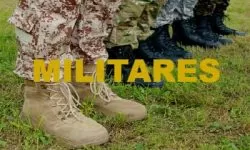
MILITARY BOOTS: Brands, Styles and Prices
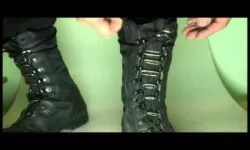
HOW TO TIE MILITARY BOOTS ?
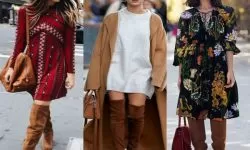
HOW TO MATCH or COMBINE BROWN BOOTS ? New Trends
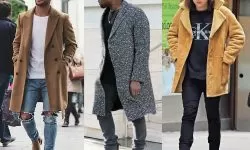
HOW TO WEAR MENS BOOTS ?
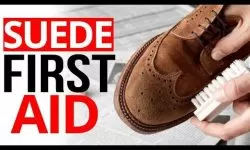
HOW TO CLEAN SUEDE SHOES ?
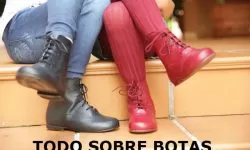
BOOTS: Brands, Models, Types and Prices
Other Topics of Interest in ALPHAPEDIA
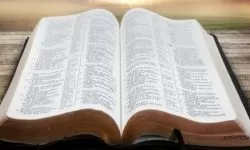
HISTORY OF ANDREW IN THE BIBLE

FREE STYLING COURSE

FREE DOCTORATE IN FINANCE

FREE MASTER DEGREE IN RENEWABLE ENERGY

MASTER DEGREE IN ADMINISTRATION

FREE MASTER DEGREE IN IRRIGATION AND DRAINAGE
COWBOYS ACCESSORIES IMAGE
